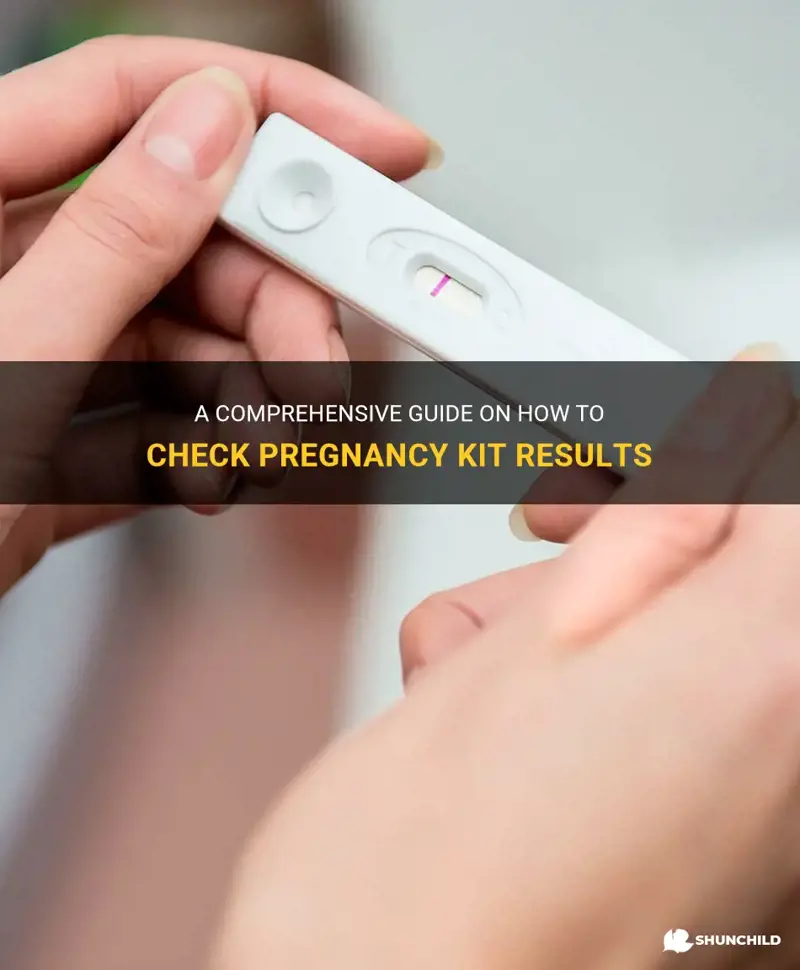
Discovering whether or not you are pregnant can be a nerve-wracking experience. Thankfully, modern technology has provided us with a simple and convenient way to check the results - pregnancy kits. These kits allow you to determine whether or not you are expecting in the comfort and privacy of your own home. If you find yourself in need of checking a pregnancy kit result, fear not! This article will guide you through the process and provide you with the information you need to interpret the results accurately. So, without further ado, let's dive into the fascinating world of pregnancy kit testing and learn how to decipher the outcome.
| Characteristics | Values |
|---|---|
| Sensitivity | Varies by brand |
| Accuracy | Varies by brand |
| Ease of use | User-friendly |
| Test method | Urine sample |
| Time to results | Usually within 5 minutes |
| Cost | Varies by brand |
| Availability | Widely available |
| Shelf life | Varies by brand |
| Packaging | Sealed, unopened package |
| Expiration date | Printed on the package |
| Language options | Multilingual instructions |
| Digital display | Some have digital results |
| Visual result | Line or symbol |
| Control line | Indicates test is valid |
| Positive result | Indicates pregnancy |
| Negative result | Indicates no pregnancy |
| Invalid result | Indicates test failure |
| Confirmation with healthcare | Recommended |
What You'll Learn
- How long should you wait before checking a pregnancy kit result?
- What does a positive result on a pregnancy kit look like?
- Can a negative pregnancy kit result be accurate if taken too early after a missed period?
- Are there any factors that can affect the accuracy of a pregnancy kit result?
- Is it recommended to use more than one pregnancy kit to confirm the result?

How long should you wait before checking a pregnancy kit result?
If you suspect that you might be pregnant, one of the most common ways to confirm it is by using a pregnancy test kit. These tests work by detecting the hormone human chorionic gonadotropin (hCG) in your urine, which is produced during pregnancy. However, it is important to know how long you should wait before checking the result to ensure accurate and reliable results.
Most pregnancy test kits on the market today claim to give accurate results as early as the day of your missed period. However, it is generally recommended to wait a few days after your missed period to test for pregnancy. This is because hCG levels may still be low in the early stages of pregnancy, and waiting a few days can help increase the accuracy of the results.
It is advisable to read the instructions that come with the pregnancy test kit carefully, as different brands may have slightly different recommendations on how long you should wait before checking the result. Some tests may suggest waiting a specific amount of time, such as 3 minutes, while others may recommend waiting until the control line appears on the test.
In general, it is best to wait at least 5-10 minutes before checking the result. This allows enough time for the hCG present in your urine to bind to the antibodies on the test strip and for the test to develop adequately. Checking the result too early may lead to a false negative, as the test may not have had enough time to detect the hCG hormone.
Once the recommended waiting time has passed, you can check the result. A positive result will usually show two lines – one control line to indicate that the test is working correctly, and another line (the test line) to indicate that you are pregnant. It is important to note that even a faint line, as long as it is clearly visible, should be considered a positive result.
On the other hand, a negative result will show only one line – the control line. It is essential to understand that a negative result does not always mean that you are not pregnant, especially if you have tested too early. If you have missed your period and continue to have pregnancy symptoms, it is recommended to wait a few days and retest using a fresh pregnancy test kit.
In some situations, you may also encounter an invalid result, which means the test did not work correctly. This could be due to various reasons, such as using an expired or faulty test kit or not following the instructions correctly. In such cases, it is recommended to repeat the test using a new kit.
To summarize, it is generally advised to wait a few days after your missed period to test for pregnancy. Most pregnancy test kits require 5-10 minutes of waiting time before checking the result. A positive result will show two lines, and even a faint line should be considered positive. A negative result does not always rule out pregnancy, especially if tested too early, and it is recommended to retest after a few days if you continue to have pregnancy symptoms.
How to Check Pregnancy in Bangla: Step-by-Step Guide
You may want to see also

What does a positive result on a pregnancy kit look like?
A positive result on a pregnancy kit can have different visual indicators depending on the brand and type of kit used. However, there are common hallmarks that can help you determine whether you are pregnant. Understanding how to interpret the results correctly is essential for accurate results and peace of mind.
- Reading the instructions: It is important to thoroughly read and understand the instructions provided with the pregnancy kit you are using. Different kits may have different methods and timeframes for reading the results. It is crucial to follow these instructions precisely to avoid confusion.
- Identifying a control line: Most pregnancy kits have a control line that serves as a reference point. It usually appears as a colored line or symbol that indicates the test is working correctly. This line should appear regardless of whether you are pregnant or not.
- Recognizing the test line: In addition to the control line, a positive pregnancy test will typically display a second line, which is often referred to as the "test line." This line is an indicator of pregnancy and will appear if the pregnancy hormone, human chorionic gonadotropin (hCG), is present in your urine. The test line can vary in intensity, ranging from a faint line to a bold and clear line, depending on the concentration of hCG in your urine.
- Time window for accurate results: Each pregnancy kit has a recommended time window during which the results are most reliable. It is important to wait the specified amount of time before interpreting the results. Reading the results too early or too late may lead to inaccurate outcomes.
Example: Let's say you are using a pregnancy kit that instructs you to wait three minutes before reading the results. After three minutes, you observe a visible control line, indicating that the test is working correctly. If a second line also appears during this time frame, even if it is faint, it is considered a positive result. This indicates that hCG is present in your urine and suggests that you are pregnant.
It is worth noting that false positives can occur due to various reasons, such as an expired or faulty pregnancy kit, certain medications, or specific medical conditions. If you receive a positive result and have concerns or uncertainties, it is recommended to consult with a healthcare professional for further confirmation.
In conclusion, a positive result on a pregnancy kit is typically indicated by the appearance of both a control line and a second line, known as the test line. It is crucial to follow the instructions provided with the kit and read the results within the specified time window. Remember that for absolute certainty, consulting with a healthcare professional is advised.
The Ultimate Guide on Pregnancy Testing in Sweden
You may want to see also

Can a negative pregnancy kit result be accurate if taken too early after a missed period?
Many women who are trying to conceive eagerly await their missed period as a sign of a possible pregnancy. However, when their period is late, they may take a pregnancy test only to receive a negative result. This can be quite confusing and raise the question of whether a negative pregnancy test result can be accurate if taken too early after a missed period.
It is important to understand that the accuracy of a pregnancy test greatly depends on the timing of the test. Pregnancy tests work by detecting the presence of a hormone called human chorionic gonadotropin (hCG) in a woman's urine. This hormone is produced by the developing placenta shortly after fertilization.
Typically, a woman's hCG levels start to rise rapidly after implantation, which occurs around 6-12 days after fertilization. In most cases, hCG can be detected in a woman's urine by a sensitive home pregnancy test around the time of her expected period. However, the actual timing can vary depending on the sensitivity of the test and the individual woman's hCG production.
If a woman takes a pregnancy test too early after a missed period, there may not be enough hCG in her urine to produce a positive result. This is particularly true for women with irregular cycles or those who ovulated later than usual. In such cases, it is possible to receive a false negative result.
To ensure the most accurate result, it is recommended to wait at least a week after a missed period before taking a pregnancy test. By this time, hCG levels will have had enough time to increase if pregnancy has occurred. If the result is still negative after waiting for a week, it is unlikely that the woman is pregnant.
It is also worth noting that some home pregnancy tests are more sensitive than others. Higher sensitivity tests can detect lower levels of hCG and therefore provide a positive result earlier after a missed period. If a woman suspects she may be pregnant and receives a negative result, she may consider trying a more sensitive test a few days later for confirmation.
Additionally, external factors such as improper test usage or dilution of urine can affect the accuracy of a pregnancy test. It is crucial to carefully follow the instructions provided with the test kit and use the first-morning urine, as it generally contains higher levels of hCG.
In conclusion, a negative pregnancy test result can be accurate if taken too early after a missed period. It is important to wait a week after the missed period before testing to allow sufficient time for hCG levels to rise. Using a more sensitive test or repeating the test a few days later can also provide further clarification. If there is still doubt, consulting a healthcare professional can help to determine the best course of action.
A Comprehensive Guide on How to Check Pregnancy Using Your Wrist
You may want to see also

Are there any factors that can affect the accuracy of a pregnancy kit result?
Pregnancy kits are widely used by women to determine whether they are pregnant or not. These kits are easy to use and provide results within minutes, making them a convenient choice for many women. However, there are several factors that can affect the accuracy of a pregnancy kit result.
- Time of testing: The accuracy of a pregnancy kit result can be affected by the time at which the test is taken. It is recommended to take the test at least one week after a missed period for better accuracy. Taking the test too early may result in a false negative as the pregnancy hormone (hCG) levels may not be high enough to be detected by the kit.
- Quality of the kit: Different pregnancy kits vary in their sensitivity and accuracy. It is important to choose a reliable and reputable brand of pregnancy kit to ensure accurate results. Low-quality kits may provide false positives or false negatives, leading to confusion and uncertainty.
- Reading the results correctly: It is crucial to follow the instructions provided with the pregnancy kit carefully to read the results correctly. Failing to do so may lead to misinterpretation of the results, resulting in inaccurate conclusions. It is important to know how to identify a positive, negative, or invalid result to ensure accurate readings.
- Medications and medical conditions: Certain medications and medical conditions can affect the accuracy of a pregnancy kit result. For example, medications that contain hCG (such as some fertility drugs) may interfere with the test and produce false positives. Similarly, certain medical conditions, such as ovarian cysts or ectopic pregnancy, can also affect the accuracy of the test.
- User error: Human error can also impact the accuracy of a pregnancy kit result. Factors such as not following the instructions properly, using expired kits, or contaminating the test can lead to incorrect results. It is important to handle the kit with clean hands and follow the instructions carefully to minimize user error.
- Testing too soon or too late: Taking the test too soon after a suspected pregnancy or waiting too long may also affect the accuracy of the result. As mentioned earlier, taking the test too early may not detect the pregnancy hormone, leading to a false negative. On the other hand, waiting too long may result in false positives as the hormone levels may decrease after a certain period of pregnancy.
In conclusion, while pregnancy kits are a convenient and easily accessible option for determining pregnancy, there are several factors that can affect the accuracy of the results. It is important to take the test at the right time, choose a reliable kit, read the results correctly, consider any medications or medical conditions, avoid user errors, and test within the appropriate window of time to ensure accurate results. It is always recommended to consult a healthcare professional for confirmation and further guidance if there is any doubt or uncertainty about the pregnancy kit result.
Ayurvedic Methods for Confirming Pregnancy: A Comprehensive Guide
You may want to see also

Is it recommended to use more than one pregnancy kit to confirm the result?
Many women who suspect they might be pregnant often wonder if it is necessary to use more than one pregnancy kit to confirm the result. While it is not always a requirement, using multiple pregnancy kits can help provide more accurate and reliable results.
Using more than one pregnancy kit can be beneficial for several reasons. Firstly, pregnancy tests work by detecting the hormone human chorionic gonadotropin (hCG) in a woman's urine. This hormone is only produced during pregnancy, so its presence in the urine confirms pregnancy. However, the amount of hCG in a woman's urine can vary, especially during the early stages of pregnancy. By using multiple pregnancy tests, it increases the chances of detecting hCG even if the levels are low in one kit but higher in another.
Secondly, every pregnancy kit has a specific sensitivity level. The sensitivity level refers to the lowest amount of hCG that a pregnancy test can detect. Some pregnancy kits have a higher sensitivity level and can detect hCG at lower concentrations, while others may require higher levels of hCG to produce a positive result. By using multiple kits with different sensitivity levels, it increases the chances of detecting a pregnancy, especially during the early stages when hCG levels are still low.
Additionally, using more than one pregnancy kit can help rule out false positives or false negatives. False positives occur when a pregnancy test detects hCG in a woman's urine, but she is not actually pregnant. This can happen due to certain medications or medical conditions that can interfere with the accuracy of the test. False negatives, on the other hand, occur when a pregnancy test fails to detect hCG in a woman's urine, even though she is pregnant. This can happen if the test is taken too early or if the hCG levels are too low to be detected. By using multiple kits, it reduces the likelihood of false results and provides a more reliable confirmation of pregnancy.
One recommended approach is to take the first pregnancy test as soon as you suspect you might be pregnant. If the result is positive, it is usually a good indication of pregnancy. However, it is still advisable to take a second test a few days later to confirm the result. This is because hCG levels double every 48-72 hours in a healthy pregnancy. By taking a second test a few days later, it allows enough time for the levels of hCG to increase, which can provide a clearer and more definitive result.
In conclusion, while using more than one pregnancy kit is not always necessary, it can provide more accurate and reliable results. By using multiple kits with different sensitivity levels and taking tests at different times, it increases the chances of detecting hCG and reduces the likelihood of false results. If you suspect you might be pregnant, it is recommended to take at least two pregnancy tests to confirm the result.
Effective Home Remedies to Check Pregnancy Without a Test
You may want to see also
Frequently asked questions
To check the result of a pregnancy test kit, first, carefully read the instructions provided with the kit. These instructions will guide you on how to use the kit correctly and interpret the results. Generally, you will need to collect your urine sample in a clean container and then either immerse the test stick directly into the urine or use a dropper to apply a few drops of urine onto a test strip. After a specified waiting time, typically a few minutes, you can check the designated area on the test stick for the result.
It is usually recommended to check a pregnancy test kit result after waiting the designated time period mentioned in the instructions, which is typically 5-10 minutes. Checking the result too early or too late can lead to inaccurate results. Checking the test too early may result in a false negative if the levels of the pregnancy hormone (hCG) in your urine are not yet detectable. On the other hand, waiting too long may lead to an evaporation line or inaccurate interpretation of the test result.
Most pregnancy test kits have two windows or lines to indicate the result: a control line and a test line. The control line usually appears as a solid line or a plus (+) sign, and it serves as a control to indicate whether the test kit is functioning correctly. The test line, which appears as a solid line or a second plus sign (+), will only appear if the test detects the pregnancy hormone (hCG) in your urine. If both the control line and the test line are visible, it typically indicates a positive or pregnancy result. If only the control line is visible, it usually indicates a negative or non-pregnant result.
While pregnancy test kits are generally accurate, certain factors can affect their reliability. Taking the test too early, not following the instructions correctly, using an expired or malfunctioning test kit, or diluting your urine sample with excessive liquid can lead to inaccurate results. Additionally, certain medications or medical conditions, such as certain fertility treatments or ovarian cysts, can give false positive or false negative results. If you are unsure about the result or believe it may be incorrect, it is recommended to consult with a healthcare professional for further testing or confirmation.







